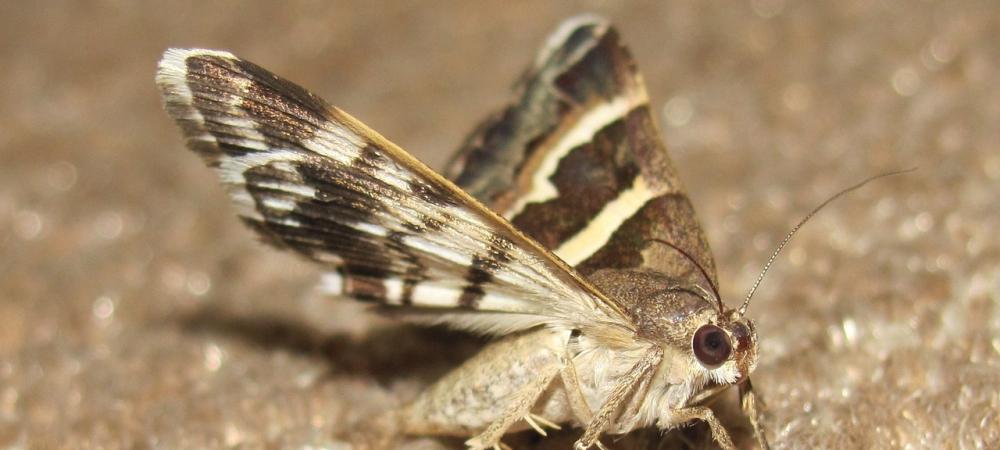Do Moths Eat Clothes?

Moths have long been associated with the destruction of clothing, particularly wool and other natural fabrics. The common belief is that moths are culprits in causing irreparable damage to our beloved garments. But, is it true? Do moths actually eat clothes, or is this notion just a myth? In this blog, we will delve into the fascinating world of moths and unravel the truth behind their alleged destructive behavior.
Do Moths Eat Fabric?
Yes, moths eat clothes, but the real culprits behind fabric damage are the moth larvae, not the adult moths themselves. Moth larvae are particularly attracted to animal fibers, such as wool, silk, and fur. These tiny, voracious eaters feed on keratin, a protein found in these natural fibers. While moths may not technically "eat" clothing, their larvae can cause significant harm by chewing through fabrics, creating holes and weakening the material.
What Do Moth Holes Look Like?
Here are some characteristics of moth holes in fabric:
- Size: Moth holes are usually small, ranging from a few millimeters to a centimeter in diameter, and they tend to be uniform in size. The size of the holes may depend on factors such as the type of fabric and the severity of the infestation.
- Shape: Moth holes are typically round or oval in shape. Unlike irregular tears or rips caused by other factors, moth holes often have a distinct and well-defined outline.
- Neat Edges: One distinguishing feature of moth holes is that they have neat edges. The fabric around the hole is not frayed or torn unevenly. This precision is a result of the way clothes moth larvae feed by chewing through the fabric.
- Clustering: Moth holes may appear in clusters, especially if there is a significant infestation. The larvae tend to feed in localized areas, creating multiple holes close to each other.
- Location: Moth holes are commonly found in hidden or undisturbed areas of clothing. For example, you might find them in the folds, cuffs, collars, or along seams where the fabric is undisturbed.
It's important to note that other factors, such as wear and tear, can cause damage to clothing that may resemble moth holes. However, the distinctive characteristics mentioned above are indicative of damage caused by clothes moth larvae. If you suspect a moth infestation, inspect your clothing carefully, especially items made of natural fibers like wool, silk, and fur. Taking preventive measures and addressing the issue promptly can help protect your garments from further damage.
Types of Clothes Moths
Clothes moths, also known as fabric or textile moths, belong to the Tineidae family. There are several species within this family that are known for infesting clothing and natural fibers. Two common types of clothes moths are the Webbing Clothes Moth (Tineola bisselliella) and the Casemaking Clothes Moth (Tinea pellionella).
Here's a brief overview of each:
Webbing Clothes Moth (Tineola bisselliella)
- Description: The adult Webbing Clothes Moth has a wingspan of about 1/2 to 3/4 inch (12–18 mm) and is buff-colored with a tuft of reddish hairs on its head. The larvae, which are responsible for fabric damage, are creamy white with a brown head and about 1/2 inch (12 mm) long.
- Behavior: Webbing Clothes Moth larvae create silken tubes or cases that they use for protection as they feed on fabrics. They may spin silken threads, creating a web-like network within the infested area.
Casemaking Clothes Moth (Tinea pellionella)
- Description: The adult Casemaking Clothes Moth is similar in size to the Webbing Clothes Moth, with a wingspan of about 1/2 to 3/4 inch (12–18 mm). It is brownish-gray and has three dark spots on its wings. The larvae are similar in appearance to Webbing Clothes Moth larvae.
- Behavior: Casemaking Clothes Moth larvae construct protective cases from silk and fabric fibers, dragging these cases with them as they move. The larvae feed on the fabric from within their portable cases.
Both types of clothes moths are known for infesting natural fibers such as wool, silk, fur, and feathers. It's the larvae of these moths that cause damage to clothing by feeding on the keratin present in these materials. While Webbing Clothes Moth larvae create webs and move freely within them, Casemaking Clothes Moth larvae construct portable cases for protection as they move and feed.
How to Prevent Moth Damage
Protecting your clothing from moth damage involves a combination of preventive measures. Here are some tips to safeguard your garments:
- Regular Cleaning: Moth larvae are attracted to sweat, oils, and other organic residues on clothing. Regularly clean and launder your garments to eliminate these attractants.
- Storage: Store wool and other susceptible fabrics in airtight containers or garment bags to prevent moths from laying eggs on them.
- Natural Repellents: Cedarwood and lavender are known natural moth repellents. Use cedar blocks or lavender sachets in your closets and drawers to deter moths.
- Temperature Control: Moths thrive in warm environments. Keeping your storage areas cool can help discourage moth infestations.
In conclusion, moths themselves do not eat clothing; it is their larvae that pose a threat to our cherished garments. Understanding the life cycle of moths and implementing preventive measures can help protect your clothing from these fabric-hungry larvae. So, the next time you spot a moth fluttering around, rest assured that it's the larvae you should be wary of, not the adult moth.
Call Pest Exterminators
But if you suspect a clothes moth infestation, it's advisable to call professional pest exterminators and take preventive measures to protect against further damage. Local pest control companies like A&C Pest Management offer a comprehensive inspection, targeted treatments, and recurring applications to ensure your home stays protected from pests like cloth moths. Contact our team today to learn more!
FAQ About Cloth Moths
Cloth moths, those pesky little insects that can wreak havoc on your favorite clothing items, are a common concern for many. In this FAQ, we'll address some key questions about cloth moths.
Do Mothball Work?
Mothballs can be effective in preventing cloth moth infestations due to the chemicals they release, such as naphthalene or paradichlorobenzene, which repel moths. However, it's important to note that some people find the odor of mothballs unpleasant, and these chemicals may pose health concerns. Alternative methods, such as cedar or lavender, can be considered for a more natural and pleasant solution to protect your clothing from cloth moth damage.
How Can You Identify A Cloth Moth Infestation?
Cloth moth infestations are often identified by the presence of small, irregular holes in clothing items. Adult moths are about 1/2 inch long, and their larvae, responsible for the damage, are tiny caterpillars that may leave silky webbing on the affected fabrics.
What Are Cloth Moths?
Cloth moths, also known as textile moths or clothing moths, are small insects that belong to the Tineidae family. They are notorious for infesting and damaging natural fibers like wool, silk, and fur.
What Attracts Cloth Moths to Clothing?
Cloth moths are attracted to clothing made of natural fibers, especially those soiled with sweat, oil, or food residues. They are also drawn to dark, undisturbed areas where they can lay eggs and feed on the organic matter present in the fabrics.
What Do Moth Larvae Feed On?
Moth larvae, commonly known as caterpillars, are voracious eaters and their diet varies depending on the species. Different species of moths have adapted to feed on a wide range of plant materials. Here are some common types of food that moth larvae may consume:
- Leaves: Many moth larvae feed on the leaves of plants. They use their mandibles to chew and consume the foliage. Some caterpillars are generalists and will feed on a variety of plant species, while others are more specialized in their leaf preferences.
- Fruits: Certain moth larvae are known to feed on fruits. They may burrow into the flesh of fruits or consume the leaves surrounding them. This can have economic implications in agriculture when fruit crops are infested by moth larvae.
- Flowers: Some moth larvae feed on the reproductive parts of flowers. They may consume petals, nectar, or other floral tissues. While feeding on flowers, these larvae may inadvertently play a role in pollination.
- Wood: Certain species of moths have larvae that bore into wood. These wood-boring caterpillars can be pests, causing damage to wooden structures or trees. The larvae break down the cellulose in the wood to obtain nutrients.
- Stored Food Products: Some moth larvae are notorious for infesting stored food products such as grains, cereals, and nuts. The larvae of pantry moths, for example, can cause contamination and spoilage of stored food.
- Wool and Natural Fibers: In the case of clothes moths (Tineidae family), their larvae have a unique diet. They feed on keratin, a protein found in animal fibers like wool, silk, and fur. This is why clothes moth larvae are often associated with damage to fabrics in closets.
It's important to recognize that the specific feeding habits of moth larvae vary widely among species. Some are highly specialized in their diet, while others are generalists capable of consuming a variety of plant materials or other substrates.
What Do Moths Eat?
Moths, like butterflies, undergo a complete metamorphosis with distinct life stages, including egg, larva (caterpillar), pupa, and adult. The dietary preferences of moths vary across these life stages:
- Eggs: Moth eggs are tiny and usually laid on the leaves of plants. The primary purpose of the eggs is to ensure the survival of the next generation. Moth eggs do not consume any food, as their role is to hatch into larvae.
- Larvae (Caterpillars): This is the stage where moths exhibit their feeding behavior. Moth larvae are voracious eaters and consume a wide variety of plant materials. The specific diet of a moth larva depends on its species. Some caterpillars feed on leaves, while others may eat fruits, flowers, or even fungi. Notably, there are certain species of moth larvae that are known for infesting stored food products such as grains or cereals.
- Pupa (Cocoon): During the pupal stage, moths undergo a transformative process inside a protective cocoon. At this stage, they do not eat any food, as their focus is on developing into the adult form.
- Adult Moths: Once moths emerge from their pupal stage, their primary goal is reproduction. Adult moths do not have functional mouthparts in many cases, and as a result, they do not feed. Their short-lived adult life is focused on finding a mate, reproducing, and laying eggs to continue the life cycle.
The feeding habits of moth larvae can vary widely based on the species, and some are more specialized in their diet than others.
What Types of Fabrics Do Moths Eat?
Moth larvae show a preference for certain fabrics over others. Wool, being a protein-based fiber, is a favorite target for moth larvae. Additionally, silk, fur, and other natural fibres can also fall victim to these tiny invaders. Synthetic fabrics, on the other hand, are generally safe from moth damage, as they lack the proteins that attract moth larvae.

